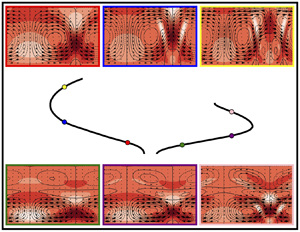Published online by Cambridge University Press: 27 July 2021

We investigate with a two-fluid model the convections developing in a gas–liquid two-phase flow, which consists of a horizontal liquid layer subject to the injection of monodisperse gas bubbles at the bottom. The convections develop in either whole- or multi-layered modes, once the gas injection flux exceeds a critical value (Nakamura et al., Phys. Rev. E, vol. 102, 2020, 053102). We determine the nonlinear evolution of these modes of flows with varying injection flux and find that the whole- and multi-layered modes develop through subcritical and supercritical bifurcations, respectively. The formation of gas plumes is observed in both cases when the nonlinearity is significant. Examining energy transfer from base to perturbation flows, we show that the lift forces on bubbles play a key role in the bifurcations. While they impede the convections in both subcritical and supercritical bifurcations at weak nonlinearity, the lift forces turn to driving the convections in the subcritical bifurcation as nonlinearity increases.
Present address: Department of Mechanical Engineering, National Institute of Technology, Ube College, Ube 755-8555, Japan.